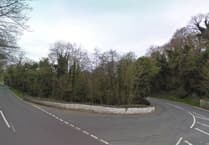Ireland and the Isle of Man have shared a long relationship deeply-rooted in mythological, religious and cultural history.
To mark St Patrick’s Day, I thought it fitting to look into the connections between one of Ireland’s patron saints, and the island that witnessed his journey across the Irish Sea.
To those that do not know already, St Patrick is another classic example of foreigners claiming to be Irish, as he was in fact, Welsh.
As a 16-year-old, St Patrick was kidnapped by Irish raiders and taken to the ‘Emerald Isle’.
He began working as a shepherd, where he turned to Christianity for comfort, being far away from home.
After six years in captivity, St Patrick is said to have heard a voice (believed to be God) telling him it was time to leave Ireland.
So he walked the 200-mile journey from what is now known as Croagh Patrick (St Patrick’s stack in English), in County Mayo and escaped to Britain.
The patron saint of Ireland’s association with the Isle of Man is disputed, for example, some say he drove snakes and venomous beasts out of the island, as he did in Ireland, however snakes can be viewed as a metaphor for paganism in this sense.
St Patrick is credited with bringing Christianity to the island, with stories claiming he came here on the way back to Ireland from Liverpool (typical) with 30 followers.
He was greeted by locals and it is said that he found ‘the people, as least the rulers, given to magic’.
The historian Train wrote that, while in Mann, the saint obtained ’fire from heaven to consume nine wizards clothed in white vestments, feigning themselves to be saints’.
The story is said to begin in AD 444 when Patrick rode his horse here over the sea.
In fear, the heathen god, Manannan, threw down his mist and set a sea-beast upon him.
The beast was turned immediately to rock and the enormous curving ridge of its back can still be seen off Peel Hill.
At St Patrick’s blessing the land ‘venomous beasts, visible devils, and a multitude of magicians’ were cast from the island.
Manannan was also banished, rolling away in the form of three legs to sink into the sea on an enchanted island.
On reaching the top, the horse stood still and a beautiful spring of water, at which both the saint and the horse refreshed themselves, sprang up at their feet.
This spring was consequently called Chibbyr Sheaant (Blessed Well), and the first Christians in the island are said to have been baptised there by the saint himself.
St Patrick’s first chapel can still be seen in the ruins of Peel Castle.
However, more than one place in the Isle of Man claims to be St Patrick’s first landing spot, with Jurby also claiming it and Rushen having potential proof with the pay-per-view hut claiming to contain the footprints of St Patrick.
There are multiple artefacts from across the island that people claim to have association with St Patrick.
Lhiabbee Pherick (Patrick’s bed), in Marown, is a slab of rock that St Patrick is said to have slept on to repent after cursing a field in anger.
A thorn pricked the saint whilst walking through the field and in frustration he cursed the field that nothing would ever grow on the land.
There are two chapels in the island that still brandish his name, in the parishes of Jurby and Patrick.
So while St Patrick may be the patron saint of Ireland, he has certainly made his impact on the Isle of Man in the past.

.jpeg?width=209&height=140&crop=209:145,smart&quality=75)



Comments
This article has no comments yet. Be the first to leave a comment.